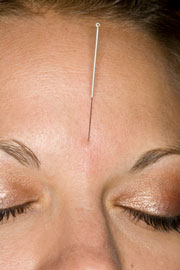A new study demonstrates that acupuncture lowers blood pressure in patients with hypertension. Researchers studied patients between the ages of 32 and 65 who were taking blood pressure medication for the treatment of high blood pressure. Prior research demonstrates that nitric oxide (NO) levels are directly related to blood pressure levels and therefore the effect of acupuncture on NO levels were also investigated. The researchers found three important changes in the patients. The systolic and diastolic blood pressure levels were reduced and the NO concentration increased.
 Acupuncture at YintangA total of ten acupuncture visits of manual acupuncture were administered to each patient at a rate of one acupuncture treatment per week. Although standard care in a typical clinic involves a custom acupuncture point prescription based on differential diagnostics, this study administered the same acupuncture points to every patient in the study. The acupuncture points were: Yintang, ST36, SP6, HT7, LI4, SP9, LV3, K3. This standards acupuncture point prescription was successful in achieving significant clinical results. The investigators concluded that acupuncture is effect in lowering blood pressure levels for patients with hypertension.
Acupuncture at YintangA total of ten acupuncture visits of manual acupuncture were administered to each patient at a rate of one acupuncture treatment per week. Although standard care in a typical clinic involves a custom acupuncture point prescription based on differential diagnostics, this study administered the same acupuncture points to every patient in the study. The acupuncture points were: Yintang, ST36, SP6, HT7, LI4, SP9, LV3, K3. This standards acupuncture point prescription was successful in achieving significant clinical results. The investigators concluded that acupuncture is effect in lowering blood pressure levels for patients with hypertension.
The treatment of hypertension using acupuncture has received a great deal of attention in research circles. Another recent study concludes that acupuncture reduces hypertension both in the long and short term. This study also concluded that both the systolic and diastolic blood pressure levels were reduced. In a somewhat similar acupoint selection, patients in the study were given acupuncture at SP9, LI4, LV3, LI11, and ST9. Similar acupuncture points and similar results, it looks as though a common thread has emerged between the two isolated studies. Acupuncture points SP9, LV3 and LI4 are common to both investigations.
Research performed at the University of California at the Irvine and Los Angeles campuses shows similar results. Acupuncture points P5, P6, LI10 and LI11 combined with electroacupuncture successfully reduced hypertension. This study also demonstrated that this acupuncture treatment prescription protected heart tissue and reduced arrhythmias in the study subjects. The University of California researchers sought to measure how acupuncture achieves this important clinical success. What they discovered unveiled some of the mysteries surrounding the medical mechanisms of acupuncture. They discovered that electroacupuncture stimulates neurons in specific brain regions that control sympathetic nerve stimulation throughout the body. The investigators mapped the neurological network stimulated by acupuncture and concluded that it is acupuncture’s ability to activate brain centers that allow it to lower high blood pressure.
References:
Severcan, C., C. Cevik, H. V. Acar, A. B. Sivri, S. S. Mit, E. Geçioğlu, O. T. Paşaoğlu, and Y. Gündüztepe. "The effects of acupuncture on the levels of blood pressure and nitric oxide in hypertensive patients." Acupuncture & electro-therapeutics research 37, no. 4 (2012): 263.
Hongguo Zhen Jiu. 2012 Sep;32(9):776-8. [Observation of anti-hypertensive effect on primary hypertension treated with acupuncture at Renying (ST 9) mainly]. Yin C, Du YZ. Graduate Faculty of Tianjin University of TCM, China.
Evidence-Based Complementary and Alternative Medicine. Volume 2012 (2012), Article ID 878673, 9 pages. doi:10.1155/2012/878673. Neuroendocrine Mechanisms of Acupuncture in the Treatment of Hypertension. Wei Zhou and John C. Longhurst. Department of Anesthesiology, David Geffen School of Medicine, University of California, Los Angeles. Department of Medicine, University of California, Irvine.

